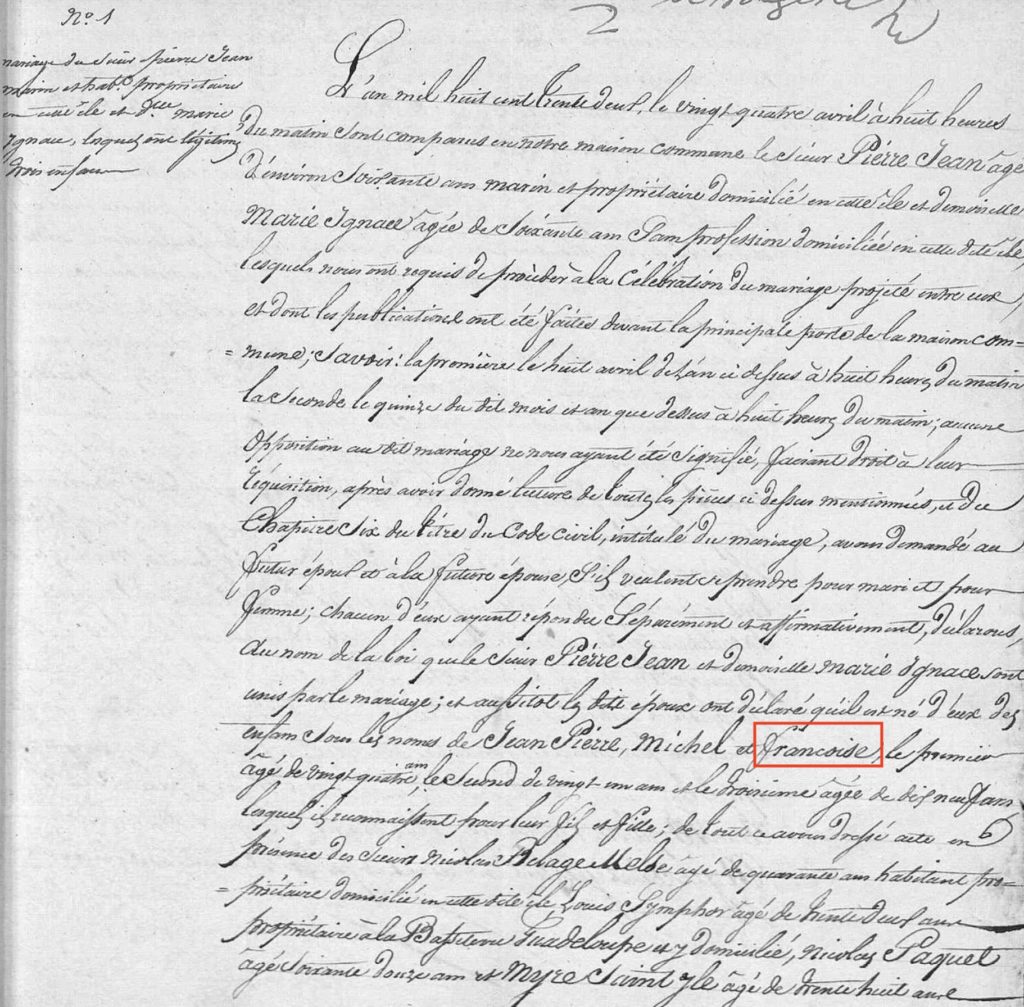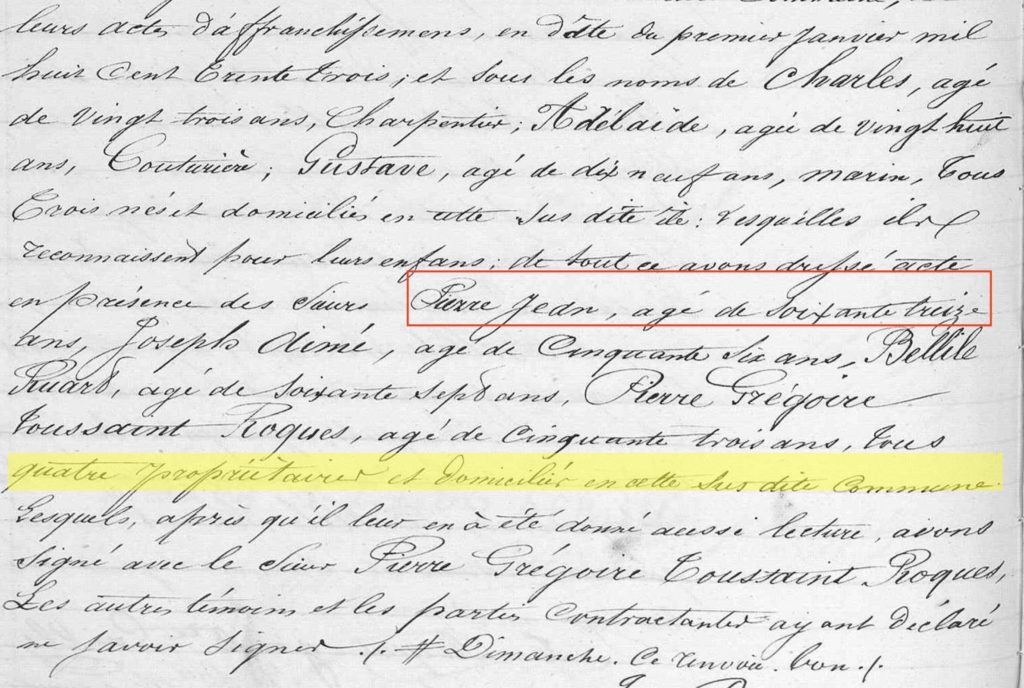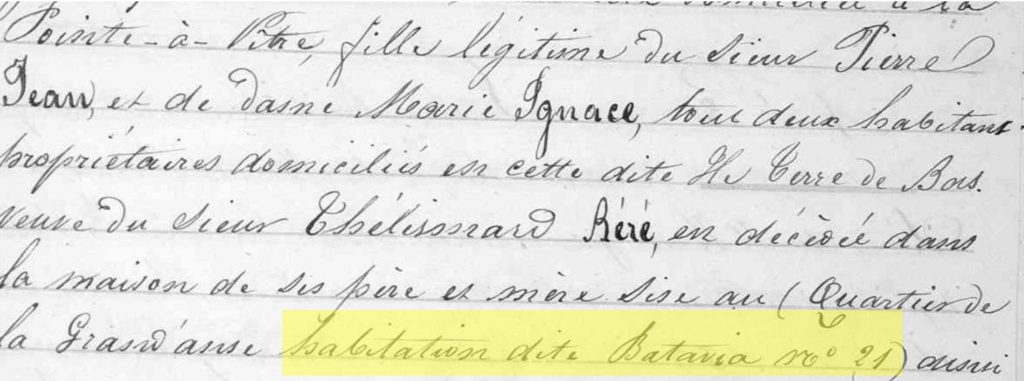When searching for family, one of the most important things I have come to realize is that sometimes we can find related family members not directly listed as “mother” or “father” in the records, but sometimes we can find them listed as the declarant, a witness, and/or listed as godparents to family members in church records. Through the help of David Quénéhervé (who has helped me limitlessly in my French Caribbean ancestral research) I came to learn that one of my ancestors was listed in another record. In this post I want to analyze his relationship in the record he was listed in and the potential familial connections.
Chaleau Jean Charles
Background: Chaleau Jean Charles is my 5th great-grandfather. He was born on the island of Terre-de-Bas, Guadeloupe around 1786 and was born enslaved. Chaleau Jean Charles became free the 2nd August 1842, he was 56 years old, and listed as a propriétaire (land owner) and charpentier (carpenter). Jean Baptiste Caille (age 46 y/o) and Paul Désiré Petit (age 30 y/o) came forward during his freedom, but so far I have no idea how these men were connected to Chaleau Jean Charles. Something interesting to note is that despite being a slave he was listed as being a land owner; I’m not sure how common this was amongst slaves in the French Caribbean but it seems that in Terre-de-Bas he was allowed to own land despite not being considered a full French citizenship.
Chaleau Jean Charles later married Marie Lucie (no last name) the 4th September 1843. She also had been previously been enslaved, but had been freed about 10 years before Chaleau Jean Charles and was freed with their children (which Chaleau was able to recognize during their marriage). Amongst those children was my 4th great-grandfather Gustave Jean Charles – born about 1821.
Finally, Chaleau Jean Charles passed away in Basse-Terre, Guadeloupe on the 31st March 1888 at around 82 years old.
A 'Hidden' Relationship
Chaleau Jean Charles appeared various times in other records, a few times appearing as the witness to marriages of people in Terre-de-Bas. So far he appears as the witness of seven weddings and one death, all on his native island. That one death is where we will concentrate ourselves in this post. It was the death of Françoise, who died the 25th January 1853.

In Françoise’s death record, two men appear: Pierre Jean, 90 years old, marine, and Jean Charles Chaleau, 65 years old, resident, and both domiciled property owners of Terre-de-Bas. The first is the father and the second the uncle of the deceased.
They both declared that Françoise was 41 years old, a seamstress, residing at Point-à-Pitre, the daughter of Pierre Jean and Marie Ignace, both inhabitants and property owners in Terre-de-Bas. She was the widow of Thélismard Réré and the record mentioned that she died in Quartier Grand-Anse on the plantation named Batavia nº 21 (dans la maison de ses père et mère – in the house of her father and mother).
So far, this is the only record discovered where Chaleau appears claiming a familial relation to someone else besides his own children.
However... Which side?
The question becomes – which side of Françoise’s family is Chaleau related to? Françoise does not seem to have a surname in her death and neither do her parents. “Jean” could have been Pierre’s father’s name or easily Pierre could have had two first names the same way his wife was named “Marie Ignace”. Similarly, Chaleau could have had three first names or that his father was named “Jean Charles”. I tend to lean to the latter theory given the fact that my 4th great-grandfather took this as a surname when he was freed.
Though Pierre Jean and Marie Ignace married in Terre-de-Bas in 1832, no parents are listed for either person. However, three children were recognized during the wedding: Jean Pierre (24 y/o), Michel (21 y/o), and Françoise (19 y/o). Both Pierre Jean and Marie Ignace are 60 years old when they married, the former listed as a marine and property owner and the latter listed as without profession.
No witness in the marriage seems to share a relationship with either bride or groom.

Potential Clues
Since we are unsure which side Chaleau was related to Françoise, there really isn’t anywhere to look (that I know of) currently. However there are two potential clues to go off of to potentially discover more.
Clue #1 (Chaleau Jean Charles’ marriage)
In this marriage record in 1843, one of the witnesses listed is “Pierre Jean, 73 years old”. This marriage occurred 10 years before Françoise’s death, both events occurring in Terre-de-Bas. Both Pierre Jean and Marie Ignace were alive when Chaleau Jean Charles married. Initially, I wanted to say that Pierre Jean was his brother, however, in this marriage record it does not state any relationship between the two men, just that his witnesses were all four property owners and living in Terre-de-Bas. I’m not sure how common women would have appeared as witnesses so maybe Pierre Jean stood in as a witness to represent his wife Marie Ignace or he stood in as Chaleau’s actually brother.

Clue #2: If we go back to Françoise’s death record, there is an important piece of information – the listing of a plantation named “Batavia nº 21”. According to the record it seems that this habitation was owned by her parents. Since they are listed as property owners, likely they either bought or inherited this land somehow. Could there be records at the Archives Nationales d’Outre-Mer about how they acquired this land? If so, would there be more information there about the relationships to others Pierre Jean and Marie Ignace would have had?

DNA - A forefront
The final step in this search would be to use DNA. Though I have matched various people from Guadeloupe, I have not been able to fully establish connections with all of them (mainly because their trees are not as complete). So there still exists the possibility that somewhere there are descendants of Pierre Jean and Marie Ignace that could provide more insight into my relationship to one side of this couple. Since DNA testing is illegal in France (for recreational purposes), it is hard to get an accurate estimate of potential cousins out there.
I hope that one day more cousins are able to test for me to be able to solidify my French Caribbean lines. In the meantime, if you are interested in reading about my current French Caribbean DNA connections – check out this previous post!
Final Thoughts
Though I end this post in a sort of limbo, I am happy to find another connection on paper to another branch of a side of my family that I did not know much of until fairly recently. Though the door has not been busted wide open to finding new connections, the crack opened was wide enough for me to be happy now.
Let’s hope that I will be able to discover more in the near future!
